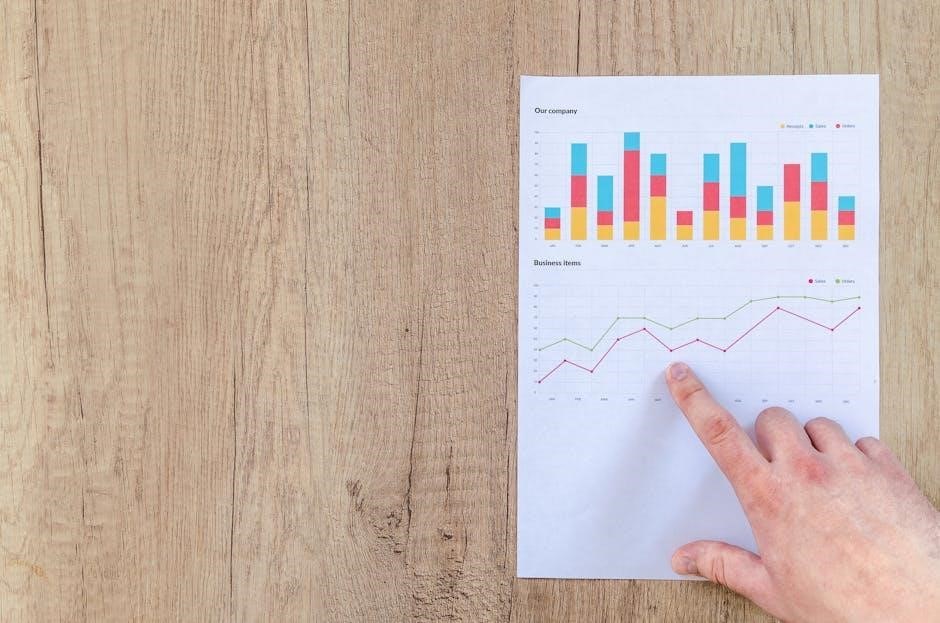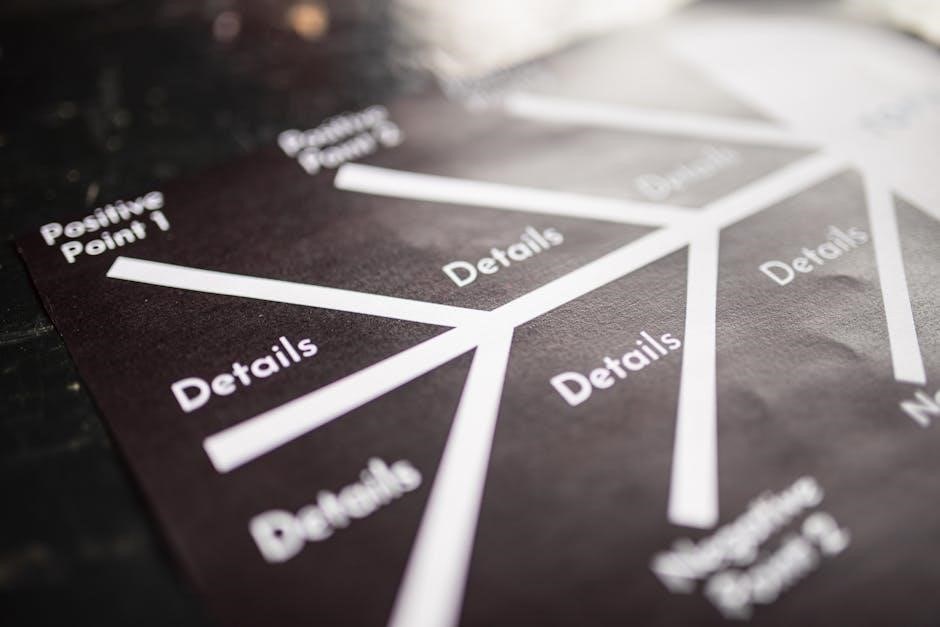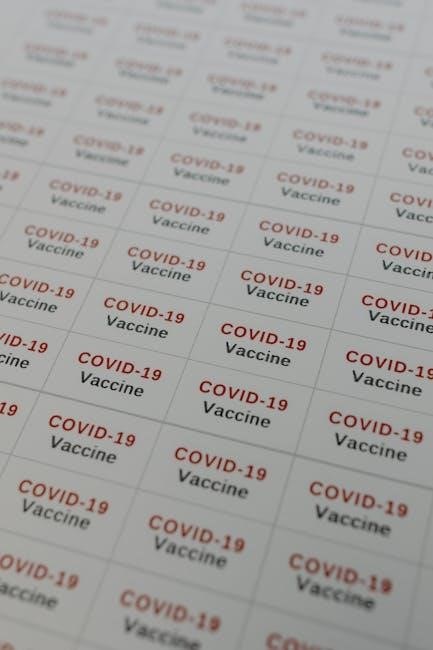Nursing report sheets are essential tools for documenting patient care, ensuring clarity and continuity in treatment plans. They integrate seamlessly with EHRs and leverage AI for efficient data management.
1.1 Definition and Purpose
A nursing report sheet is a structured document used by healthcare professionals to record patient information, treatment plans, and care outcomes. Its primary purpose is to maintain accurate, concise records of patient care, ensuring continuity and clear communication among healthcare teams. It serves as a legal document, providing a comprehensive overview of a patient’s medical history, current condition, and interventions. This tool is essential for care planning, decision-making, and ensuring patient safety, making it a cornerstone of effective healthcare management.
1.2 Importance in Healthcare Communication
Nursing report sheets play a vital role in healthcare communication by ensuring standardized documentation and accurate information exchange among healthcare providers. They reduce miscommunication, enhance patient safety, and provide a clear understanding of care plans. These documents also serve as legal records, protecting both patients and professionals. By integrating with electronic health records (EHRs) and leveraging AI for data analysis, nursing report sheets have become indispensable tools for improving care coordination and patient outcomes in modern healthcare settings.

Components of a Nursing Report Sheet
Nursing report sheets include patient identification, vital signs, medication records, progress notes, and care plans, ensuring comprehensive documentation of patient care and treatment progress.
2.1 Patient Identification Details
Patient identification details are crucial for accurate record-keeping and care coordination. These include the patient’s name, medical record number (MRN), date of birth, contact information, and insurance details. Ensuring this information is correct prevents mix-ups and ensures continuity of care. These details are typically highlighted at the top of the report sheet for quick reference; Maintaining patient confidentiality is essential, adhering to HIPAA guidelines to protect sensitive information. Accurate identification is the foundation of safe and effective patient care.
2.2 Vital Signs and Monitoring Data
Vital signs and monitoring data are critical components of nursing report sheets, providing insights into a patient’s physiological state. These include temperature, heart rate, blood pressure, respiratory rate, and oxygen saturation. Accurate and timely documentation of these metrics helps track patient progress, detect potential complications, and guide clinical decision-making. Regular monitoring ensures continuity of care and supports the development of personalized treatment plans. This data is often recorded at intervals, making it essential for effective communication among healthcare teams.
2.3 Medication Administration Record
The Medication Administration Record (MAR) is a detailed section of the nursing report sheet that documents all medications administered to a patient. It includes the drug name, dosage, route, frequency, and administration time. This record ensures medication safety, prevents errors, and provides a clear audit trail. Accurate documentation is critical for legal compliance and accountability. The MAR also facilitates effective communication between healthcare providers, ensuring continuity of care and adherence to prescribed treatment plans. It is a vital tool for monitoring patient responses and adjusting therapies as needed.
2.4 Progress Notes and Observations
Progress notes and observations document a patient’s clinical status, responses to treatments, and any notable changes. Nurses record vital signs, mental health status, and physical assessments. These notes provide insights into the patient’s recovery trajectory and guide care decisions. They also serve as a communication tool among healthcare providers, ensuring continuity of care. Accurate and timely documentation is essential for legal compliance and effective patient management. These records help track progress, identify trends, and inform future interventions tailored to the patient’s needs.
2.5 Care Plans and Interventions
Care plans and interventions outline personalized strategies to address patient needs, ensuring targeted and effective care. These plans include specific goals, actions, and timelines, often developed collaboratively with the patient and healthcare team. Interventions may involve medication, therapy, or lifestyle changes. Regular updates reflect progress and adjustments, promoting patient-centered care. Clear documentation of these plans ensures accountability and continuity, aiding in achieving desired health outcomes and improving quality of life for patients.

Formats and Templates
Nursing report sheets are available in various formats, including standard PDF templates and customizable designs. These templates ensure consistency, clarity, and efficiency in documenting patient care.
3.1 Standard PDF Templates
Standard PDF templates provide a structured format for nursing report sheets, ensuring consistency and ease of use. These templates often include pre-designed fields for patient identification, vital signs, and medication records. They are widely accessible and compatible with most electronic health record systems. PDF templates are particularly useful for maintaining a professional appearance and ensuring that all necessary information is captured. Their fixed layout also helps in maintaining compliance with legal and documentation standards, making them a reliable choice for healthcare facilities. Additionally, PDFs can be easily shared and archived.
3.2 Customizable Nursing Report Sheets
Customizable nursing report sheets allow healthcare providers to tailor documentation to specific patient needs and clinical settings. These templates can be modified to include or exclude sections, ensuring relevance and efficiency. Tools like PDF editing software enable nurses to adapt forms to their workflow, improving accuracy and reducing redundancy. Customization also supports compliance with facility-specific policies and enhances patient care by focusing on individualized needs. This flexibility makes nursing report sheets more practical and user-friendly in diverse clinical environments, ultimately improving documentation quality and streamlined communication.
3.3 Digital vs. Traditional Formats
Digital nursing report sheets offer enhanced accessibility and efficiency compared to traditional paper-based formats. They enable real-time updates, secure sharing, and integration with electronic health records (EHRs). Digital tools also reduce errors and improve legibility, while traditional formats provide a tangible record. However, paper-based systems can be time-consuming and prone to loss. The shift towards digital solutions is gaining momentum, with mobile apps and online platforms streamlining documentation processes. This transition supports better patient care and more effective communication among healthcare teams.

Legal and Ethical Considerations
Nursing report sheets must adhere to legal standards, ensuring patient confidentiality, HIPAA compliance, and accurate documentation to avoid liability and maintain ethical care practices.
4.1 Patient Confidentiality and HIPAA Compliance
Patient confidentiality is a cornerstone of healthcare ethics, requiring nursing report sheets to safeguard sensitive information. Compliance with HIPAA ensures that patient data remains protected from unauthorized access. Secure storage and transmission of nursing reports are critical to prevent breaches. Healthcare providers must adhere to strict guidelines to avoid legal consequences. Training on confidentiality protocols is essential for all staff handling patient records. This ensures trust and integrity in patient care, aligning with legal and ethical standards. Proper documentation practices further reinforce these protections.
4.2 Accuracy and Liability in Reporting
Accuracy in nursing report sheets is critical to ensure reliable patient care and avoid legal liabilities. Inaccurate or incomplete documentation can lead to miscommunication, improper treatment, and potential legal consequences. Nurses must ensure all entries are factual, objective, and free from errors. Liability arises when negligence in reporting results in patient harm. Therefore, thorough review and verification of data are essential before finalizing reports. Accurate documentation safeguards both patient well-being and professional integrity, while also protecting healthcare providers from legal risks associated with misinformation.
4.4 Documentation Standards
Documentation standards for nursing report sheets ensure consistency, clarity, and compliance with healthcare regulations. They require accurate, complete, and timely recording of patient information. Standardized formats and approved abbreviations help maintain uniformity. Adherence to these standards minimizes errors and enhances communication among healthcare providers. Regular updates and staff training ensure compliance with evolving regulations. Proper documentation supports patient safety and legal protection, while also maintaining the integrity of care records. These standards are essential for delivering high-quality, evidence-based nursing care.

Best Practices for Completing Nursing Report Sheets
Clarity, conciseness, and timeliness are critical. Use approved abbreviations, ensure accuracy, and review for errors. Regular training enhances compliance with documentation standards and legal requirements.
5.1 Clarity and Conciseness in Documentation
Clear and concise documentation is crucial for effective communication. Avoid jargon and ensure all entries are accurate and easy to understand. Use bullet points or short sentences to convey key information without ambiguity. Focus on relevant details, eliminating unnecessary data. Poor documentation can lead to misunderstandings, impacting patient care and legal standing. Clarity ensures that all healthcare team members can quickly grasp patient status and interventions. Conciseness saves time while maintaining completeness, fostering better decision-making and continuity of care.
5.2 Timeliness of Reporting
Timely reporting is vital for maintaining continuity of care. Delays in documentation can hinder decision-making and compromise patient outcomes. Nurses should complete reports as soon as possible after patient interactions. Real-time updates ensure that all team members have the most current information. Timeliness also supports legal compliance, as delayed entries may raise questions about accuracy. Prioritize prompt documentation to enhance communication, coordination, and patient safety. Regular audits can help ensure adherence to reporting timelines, fostering accountability and reliable care delivery.
5.3 Use of Approved Abbreviations
Using approved abbreviations ensures consistency and clarity in nursing documentation. Standardized abbreviations reduce errors and improve communication among healthcare teams. They must comply with organizational or regulatory guidelines, such as those from the Joint Commission or HIPAA. Approved abbreviations enhance readability and efficiency, allowing nurses to document quickly without ambiguity. Always refer to the facility’s approved list to maintain accuracy and avoid misinterpretation. This practice supports patient safety and legal compliance, ensuring clear and precise communication in care delivery.

Tools and Resources
Nursing report sheets can be efficiently managed using PDF editing software, online platforms for secure submissions, and mobile apps for on-the-go documentation and organization.
6.1 PDF Editing Software for Nursing Reports
PDF editing software like Adobe Acrobat and Foxit PhantomPDF enables nurses to modify, annotate, and manage nursing report sheets efficiently. These tools support form filling, digital signatures, and seamless integration with electronic health records (EHRs). They ensure that nursing reports are accurate, legible, and securely shared among healthcare teams. Advanced features like password protection and version control enhance document security and compliance with HIPAA standards, making them indispensable for modern nursing documentation needs.
6.2 Online Platforms for Report Submission
Online platforms simplify the submission of nursing report sheets, enabling secure and efficient sharing of patient data. Platforms like hospital EHR systems or dedicated healthcare portals allow nurses to upload PDF reports directly, ensuring real-time access for healthcare teams. These platforms often feature encryption, multi-factor authentication, and audit trails to maintain patient confidentiality and comply with HIPAA standards. They also reduce paperwork and streamline communication, making them indispensable tools for modern healthcare workflows and improving overall patient care coordination.
6.3 Mobile Apps for Nursing Documentation
Mobile apps designed for nursing documentation streamline the process of recording patient data, enabling nurses to access and update records on-the-go. Apps like Epic Haiku or Cerner Clairvia provide intuitive interfaces for inputting vital signs, medications, and progress notes directly from smartphones or tablets. They often integrate with EHR systems, ensuring seamless data synchronization. These tools enhance efficiency, reduce documentation errors, and allow nurses to focus more on patient care. Many apps also offer voice-to-text features and customizable templates, further simplifying the documentation process while maintaining HIPAA compliance and data security.

Examples and Case Studies
A sample nursing report sheet PDF provides a detailed template for documenting patient care, while real-world case studies demonstrate its practical application in clinical settings effectively.
7.1 Sample Nursing Report Sheet PDF
A sample nursing report sheet PDF provides a structured template for documenting patient care. It typically includes sections for patient identification, vital signs, medication administration, progress notes, and care plans. The PDF format ensures consistency and professionalism in reporting. It often features fillable fields for ease of use and may include approved abbreviations for efficiency. The sample serves as a guide, promoting clarity and accuracy in documentation. It aligns with healthcare standards, ensuring comprehensive and compliant patient records. This resource is invaluable for nurses to streamline their reporting processes effectively.
7.2 Real-World Applications in Clinical Settings
Nursing report sheets are widely used in clinical settings to ensure accurate and efficient documentation. They facilitate seamless communication among healthcare teams, enhancing patient care coordination. These tools are particularly valuable during shift changes, providing a clear overview of patient status and treatment plans. Integration with electronic health records (EHRs) further streamlines workflows, reducing errors and improving accessibility. Real-world applications demonstrate their effectiveness in managing patient data, fostering compliance with healthcare standards, and supporting informed decision-making at the bedside.

Training and Education
Nursing education emphasizes the importance of accurate report writing. Institutions offer courses and workshops to enhance documentation skills, ensuring nurses master effective communication and compliance standards in patient care.
8.1 Nursing Curriculum on Report Writing
Nursing schools integrate report writing into their curriculum, teaching students to document patient data accurately. Courses cover clarity, conciseness, and HIPAA compliance, preparing future nurses for effective communication and legal standards in healthcare settings. Hands-on exercises and real-world examples, like sample PDFs, are used to reinforce learning, ensuring graduates are proficient in creating detailed and precise nursing report sheets essential for patient care continuity.
8.2 Workshops on Effective Documentation
Workshops on effective documentation provide nurses with practical training in creating clear, accurate, and comprehensive nursing report sheets. These sessions often include hands-on activities, group discussions, and real-world examples, such as sample PDFs, to enhance learning. Participants learn to prioritize clarity, avoid ambiguity, and adhere to legal standards. Workshops also emphasize the importance of timely reporting and using approved abbreviations. By focusing on peer feedback and interactive exercises, these programs help nurses refine their documentation skills, ensuring better patient care and compliance with healthcare regulations.
8.3 Continuing Education Resources
Continuing education resources are vital for nurses to master nursing report sheet documentation. Online platforms offer courses, downloadable PDF guides, and webinars focused on improving documentation skills. These resources provide practical examples, such as sample nursing report sheet PDFs, to illustrate best practices. Nurses can access these tools to stay updated on legal requirements, documentation standards, and efficient reporting techniques. Such resources ensure ongoing professional development, enabling nurses to deliver high-quality, accurate, and compliant patient care documentation effectively.

Future Trends in Nursing Reporting
Future trends include AI integration for automated data entry, enhanced EHR compatibility, and advanced data security measures. These innovations aim to streamline reporting, improve accuracy, and ensure patient confidentiality.
9.1 Integration with Electronic Health Records (EHRs)
Integrating nursing report sheets with EHRs enhances care coordination by ensuring real-time data sharing across healthcare teams. This seamless connection reduces errors, improves patient outcomes, and streamlines documentation processes. EHR integration also supports compliance with regulatory standards and facilitates easier access to historical patient data. Future advancements aim to deepen this integration, enabling AI-driven insights and enhancing interoperability. This fusion of nursing reports with EHRs is pivotal in advancing the digital transformation of healthcare systems worldwide, ensuring efficient and patient-centered care delivery.
9.2 Artificial Intelligence in Nursing Documentation
AI is revolutionizing nursing documentation by automating data entry, reducing errors, and enabling predictive analytics. AI-powered tools analyze patient data from report sheets to identify trends, improving decision-making. Natural Language Processing (NLP) extracts insights from narrative notes, enhancing care coordination. AI also supports personalized care plans by leveraging historical data. As AI adoption grows, it promises to alleviate documentation burdens, allowing nurses to focus more on patient care and less on administrative tasks, thereby enhancing overall healthcare efficiency and patient outcomes significantly.
9;3 Enhanced Data Security Measures
Enhanced data security measures are critical for protecting sensitive patient information in nursing report sheets. Advanced encryption ensures confidentiality, while role-based access controls limit unauthorized entry. Regular audits and monitoring systems detect breaches early, ensuring compliance with HIPAA and other regulations. Training programs emphasize secure documentation practices, reducing human error risks. Future advancements, like AI-driven threat detection, promise even stronger safeguards, ensuring patient data remains protected in both digital and PDF formats. These measures are vital for maintaining trust and integrity in healthcare communication.
Nursing report sheets have evolved significantly, integrating technology and fostering better patient care. Their future lies in enhanced security, AI, and seamless EHR integration, ensuring efficient communication.
10.1 Summary of Key Points
Nursing report sheets are vital tools for documenting patient care, ensuring continuity and clear communication. They include patient details, vital signs, medications, and care plans, adhering to legal standards like HIPAA. Digital formats and AI are transforming these reports, enhancing efficiency and accuracy. Proper documentation practices, including clarity and timeliness, are essential for patient safety and legal compliance. These sheets play a crucial role in modern healthcare, fostering collaboration and improving patient outcomes through structured and accessible information.
10.2 Final Thoughts on the Evolution of Nursing Report Sheets

Nursing report sheets have evolved significantly, transitioning from paper-based to digital formats, enhancing accessibility and efficiency. Integration with EHRs and AI-driven tools has streamlined documentation, reducing errors and improving patient care. These advancements ensure timely, accurate, and secure reporting, fostering better communication among healthcare teams. As technology continues to advance, nursing report sheets will remain a cornerstone of patient-centered care, driving innovation and excellence in healthcare delivery.
